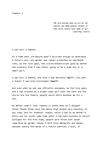User:Mxrwho/The Final Project/Thesis: Difference between revisions
No edit summary |
No edit summary |
||
| Line 9: | Line 9: | ||
'''Chapter One''' | '''Chapter One''' | ||
Where it all began. A flashback to growing up | Where it all began. A flashback to growing up in a specific society at a certain time. The labeling that came along, the personal reaction and fight against it. | ||
[[File:Ch1 Exarchou draft1 ed.pdf|Chapter I|center|141x141px]] | [[File:Ch1 Exarchou draft1 ed.pdf|Chapter I|center|141x141px]] | ||
Latest revision as of 01:03, 18 November 2024
Outline
Working title: I've Gone Back a Thousand Times
A first-person narration in a piece that could be broadly characterized as literary non-fiction (I know, Steve, I also dislike labels). Memories, shards of (self-)reflection, pieces of theory from various disciplines (phenomenology, sociology, linguistics, art theory etc) come together to express with the use of a personal yet all-encompassing story − revolving around labeling, stereotyping and its relation to self-image − the spiraling nature of change and the importance of repetition when it comes to the establishment as well as the rejection of labels. Performativity and repetition will be equally evident in the format and the content of the story, as central elements in the establishment and subverting of biases.
Chapter One
Where it all began. A flashback to growing up in a specific society at a certain time. The labeling that came along, the personal reaction and fight against it.
Chapter Two
Fast Forward to today. Are the same issues still relevant? Personal and wider view, movements, changing perceptions.
Chapter Three
What needs to be done. Methods, helpful techniques on the personal and the social level.
Ultimate Research Goals
(1) Examine how consistent negative labeling affects the individual.
(1) Examine how awareness, establishment of new habits and positive narratives affect building resilience against negative labeling.
(2) Examine how repetition bias and the cultivation of empathy foster positive stereotyping.
(3) Examine the effect of positive vs negative labeling.
References

